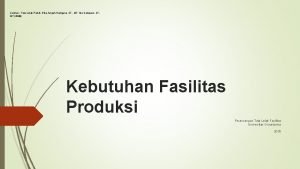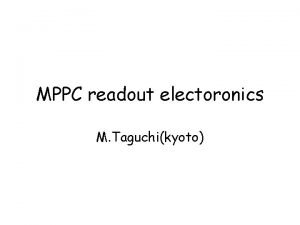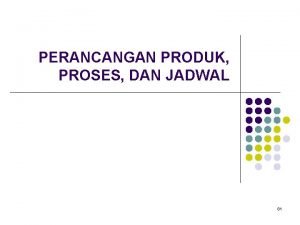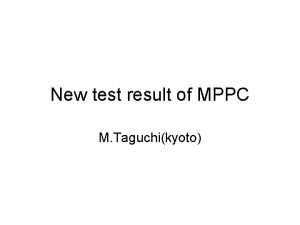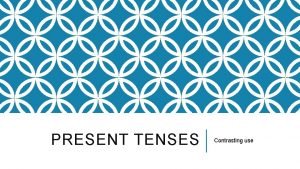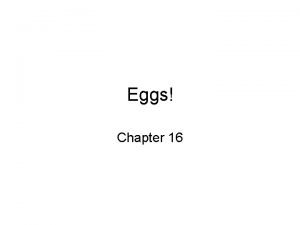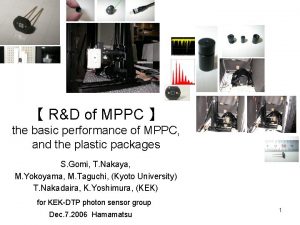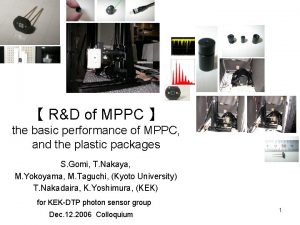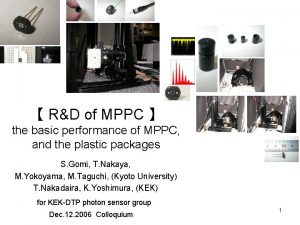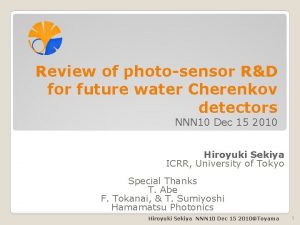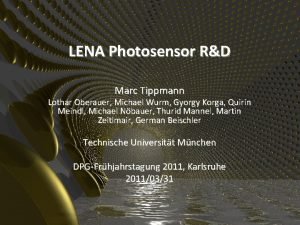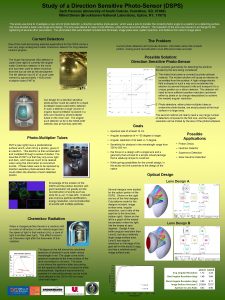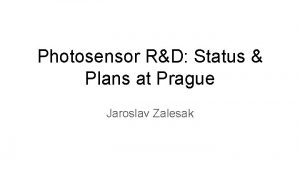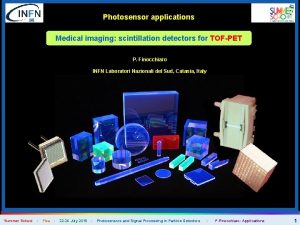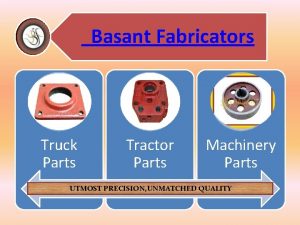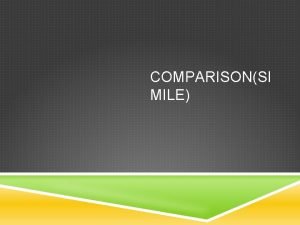Comparison of Different Hamamatsu MPPC Parts PHOTOSENSOR WG



























- Slides: 27

Comparison of Different Hamamatsu MPPC Parts PHOTOSENSOR WG MEETING Kurt Francis 10/23/2018 1

Hole Wire Bond MPPCs • Most of the Hamamatsu MPPCs we have used are of the same silicon design (S 13360) : • Vbr > 50 V • But Standard wire bond MPPC don’t pack together well (dead space where bonds are) • Quartz window (cryomppc’s) have packaging that has even more dead space • Through silicon via (TSV) MPPCs pack together well but are expensive to produce • Hole Wire Bond MPPCs (S 14160) have same packing characteristics as TSV but use a wirebond through a hole in the middle in place of TSV • • • Cheaper to produce than TSV parts Also, different silicon structure with lower Vbr ~ 37 V Higher capacitance Higher gain Less temperature dependence 2

Some Specifications from Data Sheets 6 mm x 6 mm Hamamatsu MPPCs type pixels PDE (%) gain S 13360 14336 40 1. 70 E+06 S 14160 14331 50 2. 50 E+06 terminal dark count dark capacitance typical current p. F 2 Mcps max 6 Mcps 2. 5 u. A Vbr delta. Tvop 130053+/-5 V 54 m. V/C 200037 V 34 m. V/C 3

To Study differences we created a circuit board with at least two of each type • Allows data to be taken at the same time and under the same conditions for a better comparison • Connects to SSP through LEMO-2 and Gor cables • Also connects to Keithley 6485 picoammeter (for IV studies) 4

Properties we Studied • Current-Voltage Characteristics with Keithley pico. Ammeter • Current vs Voltage response (IV curves) • Breakdown Voltage (Vb) warm and cold from IV and gain • Quenching resistance warm and cold by studying the forward bias response • Pulse Measurements with SSP • • • Pulse height/amplitude and integral of pulse in sample window Pulse shape Dark Count Rate Afterpulsing Crosstalk 5

IV CURVES Vbreak down h 1 h 2 t 1 t 2 q 1 q 2 warm IV cold gain cold IV delta 38. 3 31. 6 38. 2 31. 4 31. 5 51. 9 42 42. 1 51. 9 42. 1 52. 8 42. 8 6. 7 9. 8 10 Vover + 1 6

Current (u. A) WARM 7

holewirebond TSV Quartz window H 1 H 2 T 1 T 2 Q 1 Q 2 Rq slope Rt (Ohm) pixels Rq (Ohm) (k. Ohm) 29. 1 34. 36426 14331 492474 492 28. 7 34. 84321 14331 499338 499 31. 8 31. 44654 14336 450818 451 31. 1 32. 15434 14336 460965 461 27. 5 36. 36364 14336 521309 521 28. 5 35. 08772 14336 503018 503 From Ardavan: ・S 13360 -6050 CS/VE: ・S 14160 -6050 HS: 350 kohm 450 kohm 8

Current (u. A) COLD holewirebond TSV Quartz window H 1 H 2 T 1 T 2 Q 1 Q 2 Rq (k. Ohm) 1620 1672 943 994 1221 1174 9

Pulse Measurements • For HWB parts used Vover=2. 5 -> PED=45% • For TSV parts used Vover = 3 -> PED=40% • For each run find pedestal/baseline by looking at first 100 samples of first 500 events • For amplitude plot – find ADC value of highest ADC in sample window of 450 to 650 , synchronized with LED light pulse • For Integral plot – Add ADC – pedestal of samples 450 to 650 10

Example Pulse amplitude and Pulse Integral Plots HWB#1 Pulse Amplitude Integral Of Pulse HWB#2 Pulse Amplitude Integral Of Pulse

Example Pulse amplitude and Pulse Integral Plots TSV#1 Vovr = 2. 9 V Integral Of Pulse Amplitude TSV#2 Integral Of Pulse Amplitude 12

CRYO#1 (dimmer. LED) CRYO#2 Integral Of Pulse Amplitude 13

AMPLITUDE vs INTEGRAL HWB#1 HWB#2 Amplitude (ADC) 14

AMPLITUDE vs INTEGRAL TSV#1 TSV#2 Amplitude (ADC) 15

AMPLITUDE vs INTEGRAL Quartz / Cryo #2 Quartz / Cryo #1 Amplitude (ADC) 16 Amplitude

TSV QUARTZ/CRYO HOLE WIRE BOND RED BOX GOOD, “NORMAL”, 1 PE PULSE 17

TSV QUARTZ/CRYO GREEN BOX GOOD LOOKING PULSE, BUT >1 PE PULSE And < 2 PE 18

QUARTZ/CRYO HOLE WIRE BOND PURPLE BOX: DELAYED CROSSTALK? 19

TSV AFTERPULSES or DELAYED CROSSTALK 20

HOLE WIRE BOND AFTERPULSES or DELAYED CROSSTALK 21

Dark Count Rate SSP setting 165 170 175 180 Vop 33 34 35 36 Vbr 31. 5 Vovr 1. 5 2. 5 3. 5 4. 5 SSP setting 220 225 230 235 240 Vop 44 45 46 47 48 Vbr 42 42 42 Vovr 2 3 4 5 6 SSP setting hwb 1 hwb 2 dcr(Hz) 1 12. 9 18. 2 47. 9 PDE 1 9. 2 15. 1 34. 5 45% tsv 1 tsv 2 cryo 1 dcr(Hz) 3 7. 3 19. 5 16. 5 20. 3 1. 2 8. 9 9. 5 10. 4 13. 2 3 4. 7 6. 5 6. 7 9 PDE 46% cry 02 220 225 230 235 240 Vop 44 45 46 47 48 Vbr 42. 8 Vovr 1. 2 2. 2 3. 2 4. 2 5. 2 dcr(Hz) 0. 1 2. 3 6. 4 7. 1 9. 2 43% 22

Summary • All three types survive and function an LN 2 temperatures – so far no sign of damage/cracking • The HWB type shows less temperature dependence • The HWB have higher gain and higher noise • The Quenching resistance gets greater at LN 2 temperatures • Though Rq of the three types is close at room temp 350 Ohm to 450 Ohm, at LN 2 Temp. Rq(hwb)->1. 6 Mohm, Rq(tsv)->950 k. Ohm, Rq(cryo)->1. 2 Mohm 23

Summary • TSV and Quartz/Cryo devices have a spectrum of pulses heights between integral PE peaks, seen in both Amplitude and Integral plots • HWB has clearly separated PE Peaks in both Pulse Amplitude and Integral plots • HWB appears to high afterpulsing or delayed crosstalk • HWB devices have a higher Dark Count Rate compared to the other two types at similar overvoltage but at equivalent PDE the DCR is comparable • All three types have high crosstalk at LN 2 temperatures • (For the HWB type the crosstalk is delayed) 24

backup 25

LN 2 Dark Count Rate Detail and Crosstalk DARK COUNTS AMPLITUDE Hole Wire Bond#1 DCR=20. 5 Hz Crosstalk=14% DARK COUNTS AMPLITUDE TSV#1 DCR=10 Hz Crosstalk=30% 26

Compare With and Without Light 27
 Multi product process chart
Multi product process chart Mppc
Mppc Rancangan produk rancangan proses dan rancangan skedul
Rancangan produk rancangan proses dan rancangan skedul Mppc
Mppc Direct comparison test
Direct comparison test Present progressive
Present progressive Why do different polymers have different properties
Why do different polymers have different properties Flame test principle
Flame test principle Sound will travel at different speeds in different mediums.
Sound will travel at different speeds in different mediums. Library thinkquest org 19537
Library thinkquest org 19537 Cultural relativism
Cultural relativism Different angle different story
Different angle different story Acids and bases song lyrics
Acids and bases song lyrics Different materials have different
Different materials have different Different people different things
Different people different things Argumenterande tal struktur
Argumenterande tal struktur How many bones are in your arm
How many bones are in your arm Different parts of body
Different parts of body Label a bean seed
Label a bean seed Explain parts of bar
Explain parts of bar Labelled diagram of egg
Labelled diagram of egg What are the main parts of a story
What are the main parts of a story Part of story structures
Part of story structures What are the 7 parts of a plant?
What are the 7 parts of a plant? Different parts of a stage
Different parts of a stage Different parts of the internet
Different parts of the internet Different part of plants
Different part of plants Parts of a plant
Parts of a plant
